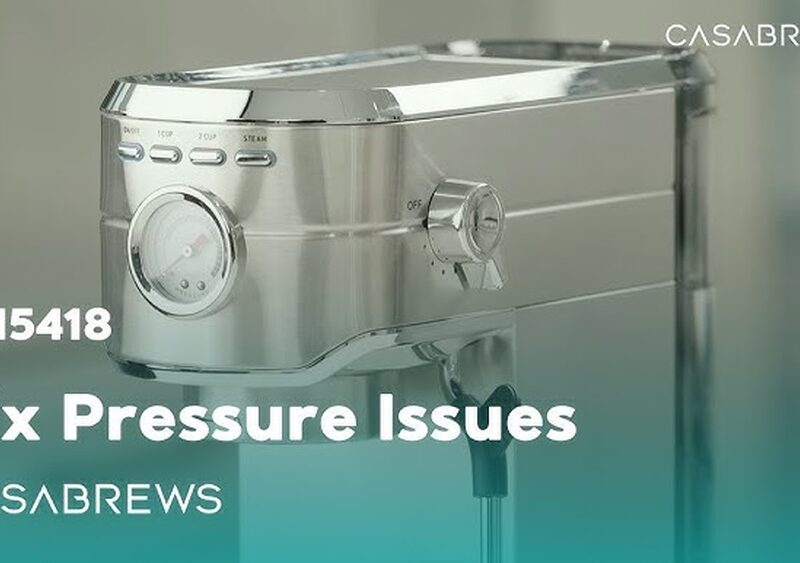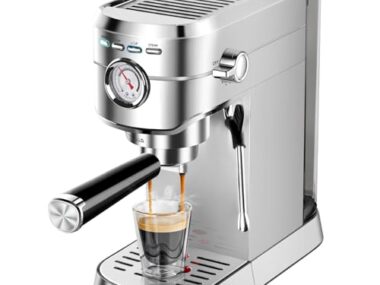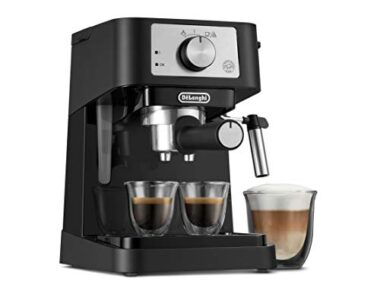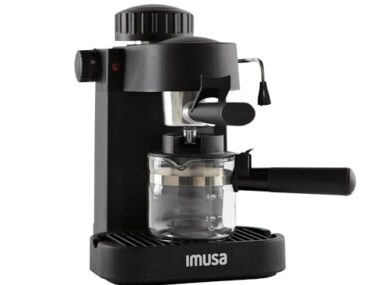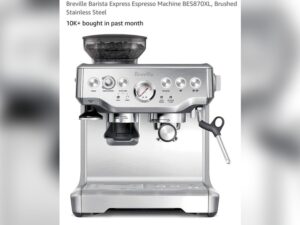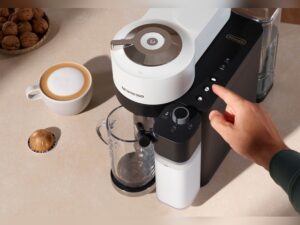Is your espresso machine not building enough pressure? You’re not alone, and the good news is—it’s often an easy fix.
When your machine’s pressure is off, your espresso shots can turn out weak, watery, or just plain disappointing. But don’t worry; with a few simple adjustments, you can bring that rich, bold flavor back to your cup. In this guide, you’ll learn the key reasons why your espresso machine might be struggling with pressure and exactly how to fix them.
Keep reading to discover quick tips that will have your espresso tasting just right again.

Credit: cliffandpebble.com
Common Pressure Issues
Pressure problems are common in espresso machines. They affect the quality of your coffee. Understanding these issues helps you fix your machine fast. Pressure must be just right to extract the best flavors.
Too low or too high pressure can ruin your espresso. Each problem has its own causes and signs. Knowing these makes troubleshooting easier.
Low Pressure Causes
Low pressure happens when water flows too fast through the coffee. A coarse grind lets water pass quickly. Using too little coffee also reduces resistance. Light tamping means the coffee grounds are loose. This lets water escape without building pressure. Blockages in the machine can reduce pressure. Old coffee oils and mineral deposits block water flow.
High Pressure Problems
High pressure means water struggles to pass through the coffee. A grind that is too fine clogs the filter. Too much coffee in the basket creates tight packing. Over-tamping compresses the grounds too hard. These cause excessive resistance. The pump works harder and pressure rises above normal. This can damage the machine or cause bitter coffee.
Symptoms Of Pressure Issues
Low pressure makes espresso weak and watery. The shot pulls quickly and lacks crema. High pressure causes slow shots and bitter taste. You may hear strange noises from the machine. Sometimes, the machine stops pumping water. Watch for leaks or steam escaping oddly. These signs show pressure is not right.
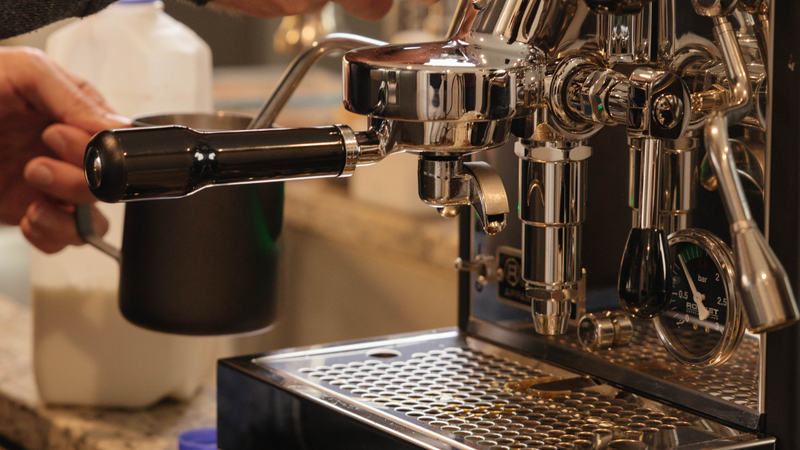
Credit: cliffandpebble.com
Adjusting Grind Size
Adjusting the grind size plays a key role in fixing espresso machine pressure issues. The grind size controls how fast water passes through the coffee grounds. Too coarse or too fine a grind can affect pressure and shot quality. Small changes in grind size can improve resistance and help achieve the perfect espresso pressure.
Effects Of Coarse Grind
A coarse grind allows water to flow too quickly through the coffee. This fast flow reduces pressure and causes under-extraction. The espresso shot may taste weak and watery. Coarse grounds do not create enough resistance for the machine to reach ideal pressure. Adjusting to a finer grind increases resistance and improves shot strength.
Finding The Right Grind
The correct grind size is between coarse and too fine. It creates balanced resistance for water to pass evenly. This balance helps the machine build proper pressure. Aim for a grind that feels similar to table salt. It should not be powdery or chunky. Testing different settings helps find the best grind for your espresso machine.
Incremental Grind Changes
Make small adjustments when changing grind size. Move one step finer or coarser and test the shot. Large changes can cause over-extraction or clogging. Note how each change affects pressure and taste. Repeat until the espresso flows at the right speed and pressure. Patience and small steps lead to the best results.
Managing Coffee Dose
Managing the coffee dose is key to fixing espresso machine pressure issues. The right amount of coffee creates proper resistance for the water. This resistance helps the machine build enough pressure to extract rich flavors. Too little or too much coffee affects shot quality and pressure. Understanding how to measure and adjust the dose makes a big difference.
Impact Of Under-dosing
Under-dosing means using less coffee than needed. This causes water to flow too fast through the grounds. The machine cannot build enough pressure. The espresso tastes weak and watery. The shot lacks body and flavor. Using too little coffee reduces resistance and pressure inside the portafilter.
Proper Coffee Amount
Each espresso basket has a recommended coffee dose. This dose ensures the right resistance for proper pressure. Generally, a single shot uses about 7 grams of coffee. A double shot needs around 14 grams. Using the correct amount fills the basket well. It creates a dense coffee puck for water to push through slowly.
Measuring Techniques
Use a digital scale for accurate dosing. Place your portafilter on the scale before adding coffee. Add grounds until you reach the desired weight. Avoid guessing or eyeballing the dose. Consistent measurements help maintain steady pressure and flavor. Level the coffee evenly before tamping to avoid weak spots.

Credit: www.youtube.com
Tamping Techniques
Tamping is key to fixing espresso machine pressure issues. It helps form a compact coffee puck. This puck slows water flow. Proper tamping increases pressure and improves flavor extraction.
Using the right tamping technique creates resistance. This resistance allows the machine to build correct pressure. Poor tamping causes weak or watery espresso shots.
Importance Of Firm Tamping
Firm tamping packs the coffee grounds tightly. It prevents water from flowing too fast through the puck. This slow flow lets the water extract full flavor from the coffee.
Without firm tamping, espresso shots can taste weak or sour. Apply about 30 pounds of pressure for best results. This pressure creates a dense puck that holds water well.
Achieving Even Pressure
Even pressure during tamping avoids channeling. Channeling happens when water finds weak spots and flows too quickly. This causes uneven extraction and poor taste.
Hold the tamper level and press straight down. Avoid tilting or twisting the tamper. Practice helps develop a smooth and consistent tamp every time.
Common Tamping Mistakes
Light tamping leads to weak espresso with low pressure. Too light pressure means water flows too quickly.
Uneven tamping causes water to find gaps in the coffee puck. This reduces pressure and flavor quality.
Using a dirty or wet tamper can also affect tamping quality. Keep your tamper clean and dry before each use.
Cleaning And Maintenance
Maintaining your espresso machine properly keeps the pressure steady and the coffee tasty. Dirt, coffee oils, and mineral deposits can block water flow. These blockages lower the pressure and harm the machine’s performance. Cleaning and maintenance help avoid these problems. This section covers key steps to keep your espresso machine in top shape.
Removing Blockages
Blockages often form in the group head and portafilter. Use a brush to clean coffee grounds after each use. Check the shower screen for clogged holes. Remove it and soak in warm water if needed. Clear any debris from the steam wand too. Regularly removing blockages ensures smooth water flow and proper pressure.
Descaling The Machine
Mineral buildup inside the machine affects pressure and taste. Descale your espresso machine every 1-3 months. Use a descaling solution or a mix of vinegar and water. Run the solution through the machine as if brewing coffee. Then flush with clean water to remove residue. Descaling protects the internal parts and keeps pressure stable.
Regular Cleaning Routine
Create a daily and weekly cleaning schedule. Wipe down the exterior and clean the drip tray daily. Backflush the machine weekly using a cleaning tablet. Remove and clean the portafilter and baskets. Deep clean the group head monthly. A consistent routine prevents buildup and keeps the pressure at the right level.
Testing And Troubleshooting
Testing and troubleshooting pressure issues in your espresso machine is crucial for consistent coffee quality. It helps pinpoint the root cause of low or unstable pressure. This process involves checking the machine’s pressure gauge, timing your espresso shots, and understanding when professional help is necessary. Each step provides important clues to fix the pressure problem effectively.
Pressure Gauge Checks
Start by observing the pressure gauge during extraction. The ideal pressure usually ranges from 9 to 10 bars. If the gauge shows lower pressure, the machine may have blockages or pump issues. A steady pressure reading means the pump is working correctly. Sudden drops or spikes indicate possible leaks or faulty parts. Regularly clean your espresso machine’s group head and portafilter to avoid pressure drops caused by clogging.
Shot Timing And Flow
Measure the shot time to evaluate pressure performance. A proper espresso shot takes about 25 to 30 seconds. Faster shots usually mean low pressure or coarse grind size. Slow shots can indicate overpressure or too fine a grind. Observe the flow; it should be steady and thick, not watery or dripping. Adjust the grind size and tamping pressure to improve resistance and reach optimal shot timing.
When To Seek Professional Help
Some pressure problems require expert attention. Contact a technician if the pressure gauge is broken or the pump is noisy. Persistent pressure drops despite cleaning and adjustments also need professional service. Avoid opening the machine yourself if you lack experience. Professional repair ensures safety and prevents further damage. Regular servicing helps maintain pressure and prolongs your espresso machine’s life.
Frequently Asked Questions
Why Is My Coffee Machine Not Building Up Pressure?
Your coffee machine lacks pressure because water flows too quickly through coarse grounds, light tamping, or low coffee dose. Adjust grind finer, tamp firmly, and use enough coffee. Clean machine parts regularly to prevent blockages and maintain proper pressure during extraction.
Why Is My Espresso Machine Pulling Weak Shots?
Weak espresso shots often result from a coarse grind, light tamping, or under-dosing. Adjust grind finer, tamp firmly, and use enough coffee. Clean machine parts regularly to prevent blockages and ensure proper water flow and pressure for better extraction.
How To Tell If An Espresso Pump Is Bad?
Signs of a bad espresso pump include low or no pressure, inconsistent shots, strange noises, and failure to start. Check for leaks or weak water flow.
Why Is The Pressure Gauge Not Working On My Espresso Machine?
The pressure gauge may not work due to blockages, faulty sensors, or electrical issues. Clean and inspect the machine regularly. Adjust grind size and tamp pressure to ensure proper resistance and pressure build-up.
Conclusion
Fixing espresso machine pressure improves your coffee’s taste and strength. Check grind size, dose, and tamping pressure carefully. Clean your machine regularly to avoid blockages. Small adjustments make a big difference in pressure levels. Enjoy richer, fuller espresso shots every time.
Keep practicing these simple steps for consistent results. Your perfect espresso is within reach.
